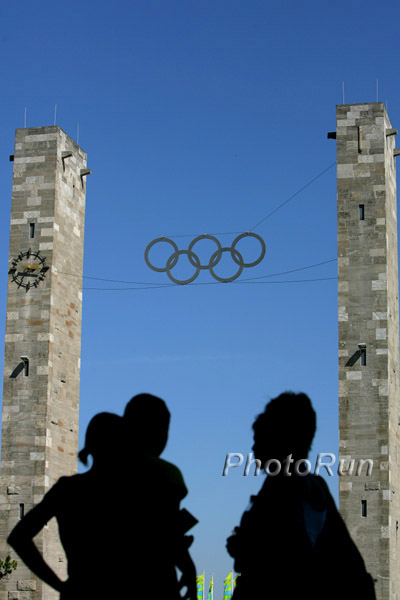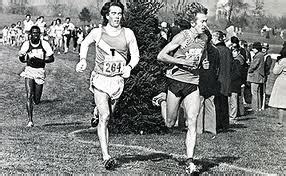
Berlin 1936 Olympic rings, photo by PhotoRun.net
Elliott Denman writes about the new film that reminds us of the Berlin Nine, “The Renaissance of the African American in Sports.”
RENAISSANCE FILM…
By ELLIOTT DENMAN
“I am shocked how many young people don’t know who Jesse Owens is,” Bob Lott tells his audience.
And that became the noted film producer and director’s primary motivation in creating “The Renaissance Period of the African American in Sports.”
It is a 22-minute documentary that opened to a World Premiere gathering of enthusiastsThursday (May 15) at the Walter Reade Theater at New York City’s Lincoln Center.
Another event earlier this day was designed to shock participants into the never-forget mode – dedication of the National September 11 Museum at the former Ground Zero in lower Manhattan.
“The Renaissance Period” has the same intent; only problem, as Lott puts it, is that vast numbers have more than just forgotten Jesse Owens and his legacy – but likely were never familiar with it in the first place.
Just as some modern-day baseball players cannot identify Jackie Robinson – yes, all that was made clear several years ago – too many others have no idea of Jesse Owens’ role in the world of sports, or the real world of the African-American struggle for a full and free role in
modern-day America.
Jesse Owens was the boyhood hero of Herb Douglas – the Pittsburgh product and Pitt graduate who created the Jesse Owens International Trophy Award as the best kind of alternative to the AAU’s James E. Sullivan Award, which did not present its “amateur athlete of the year” award to Owens after his magnificent, nonpareil, four-gold medal performance under the eyes of Nazi dictator Adolf Hitler at the 1936 Berlin Olympic Games.
Matter of fact, the AAU didn’t present it to an African-American until “Marvelous Mal” Whitfield in 1954 (midway between his two Olympic 800-meter crowns.)
“That really motivated me,” said Douglas, the 1948 Olympic long jump gold medalist – and oldest living African-American Olympic medalist, now a 92-year-old Philadelphian with the energy supply of a man half his age.
It’s motivated him in myriad ways ever since, and one of the most nota
ble will surely be this film. He prodded long-term friend Lott into getting it done, after prodding his supporters at the University of Pittsburgh (led by Chancellor Mark A. Nordenberg) and at Schieffelin & Co. (now evolved into Moet/Hennessy USA), where he rose up through the ranks to a vice-presidency in a brilliant and groundbreaking business career, into providing the wherewithal.
They’re all gone now – the nine pioneering African-Americans who brought 13 Berlin medals (eight gold, three silver, two bronze) home to their nation, only to endure the indignities heaped on them by fellow Americans still years away from desegregation, the Civil Rights movement, and the progress made beginning under the presidencies of Harry Truman and Dwight Eisenhower.
Of course, Owens was in their pantheon. How could he be anything else after sweeping to historic golds in the 100 and 200-meter dashes, the broad (now long) jump, and the 4×100-meter relay?
But the other eight played roles just as critical in the dismantling of Hitlerian “super race” theories and his vicious attempt to label these superb Americans as “black auxiliaries.”
There was John Woodruff, the Pitt freshman who maneuvered through difficult traffic jams to win the Berlin 800 meters, ending a run of four consecutive British wins in the two-lap event. (At the 1939 Penn Relays, he anchored Pitt to four brilliant relay wins; in an incredible turn of events, the Pitt 4×400 team won at the 2014 Penn Relays, as the best of possible 75-year commemorations.)
There were West Coasters Archie Williams (of Cal-Berkeley) and Jimmy LuValle (of UCLA) who ran 1-3 in the 400-meter final. (But who strangely – and bitterly – were left off the USA team in the 4×400 relay final, a race USA, running with four Caucasian athletes, lost to
Great Britain.)
There was Marquette graduate Ralph Metcalfe, who’d chased USA teammate Eddie Tolan to two sprint medals at the 1932 Los Angeles Games, and would add a silver (running second to Owens in the 100) and a gold (joining Owens, Foy Draper and Frank Wykoff in the 4×100 relay at Berlin.
There were high jumpers Cornelius Johnson (of Compton, Calif.) and Dave Albritton (of Ohio State) who’d go 1-2.
There was Matthew “Mack” Robinson (Jackie’s big brother, of Pasadena, Calif. and the University of Oregon) who’d run second to Owens in the 200.
And there was University of North Dakota student Frederick “Fritz” Pollard Jr. – son of former Brown University football All-American Fritz Sr. – who took the bronze medal in the 110-meter high hurdles.
They did all this in an era when major league baseball and the National Football League played by the rules of Jim Crow and before pro basketball became a viable entity.
(History note: NFL Hall of Famer Fritz Pollard Sr. actually played in and served as head coach in the NFL, before the le
ague succumbed to racism and drew a color line in 1926.)
Even black jockeys – once prominent on the racetracks of America – seemed to disappear from the scene.
Boxing was the primary professional sport open to African-Americans, and played its own major role in bridging the racial divide. When Germany’s Max Schmeling knocked out America’s Joe Louis months before the Berlin Olympics, the nation groaned. But when Louis knocked out Schmeling in the first round of their 1938 rematch, America roared its approval.
All these years later, it’s time for the nation to take an urgent class in remedial education.
All of us need to be reminded of the epic deeds of the Berlin Nine – Jesse Owens, John Woodruff, Archie Williams, Jimmy LuValle, Ralph Metcalfe, Cornelius Johnson, Mack Robinson and Fritz Pollard Jr.
Just as it was with Woodruff’s post-Berlin return to Pittsburgh inspiring Herb Douglas, Owens’ return to Cleveland inspired a young man named Harrison Dillard, who became (to many) the finest high hurdler in track and field history, and a winner of two gold medals at the 1948 London Games, and two at Helsinki in 1952.
As President Barack Obama once famously said of those paved who paved the way to his own historic opportunity, “I’m standing on your own shoulders.”
Well, let it be known that multi-medaled Carl Lewis, Edwin Moses, Lee Calhoun, Roger Kingdom, Tommie Smith, John Carlos, Charlie Dumas, Bob Hayes, Charlie Greene, James Hines,Greg Bell, Bob Beamon, Randy Williams, Arnie Robinson, Mike Powell, Herman Frazier, Michael Johnson, Milton Campbell, Charley Jenkins Sr. (and Charley Jr.), Lee Evans, Larry James, Ron Freeman, Henry Carr, Andrew Valmon, Steve Lewis, Al Joyner, Kenny Harrison – and so many more – were standing on the shoulders of the Berlin Nine.
Plans are to screen “The Renaissance Period” to college (and hopefully high school) audiences around the nation now through Olympic Year 2016.
That, of course, would be the 80th anniversary of the Berlin Games.
The film is factual and thought-provoking. Its message needs to be told.
Let its road trip begin.
###
Larry Eder has had a 52-year involvement in the sport of athletics. Larry has experienced the sport as an athlete, coach, magazine publisher, and now, journalist and blogger. His first article, on Don Bowden, America's first sub-4 minute miler, was published in RW in 1983. Larry has published several magazines on athletics, from American Athletics to the U.S. version of Spikes magazine. He currently manages the content and marketing development of the RunningNetwork, The Shoe Addicts, and RunBlogRun. Of RunBlogRun, his daily pilgrimage with the sport, Larry says: "I have to admit, I love traveling to far away meets, writing about the sport I love, and the athletes I respect, for my readers at runblogrun.com, the most of anything I have ever done, except, maybe running itself." Also does some updates for BBC Sports at key events, which he truly enjoys. Theme song: Greg Allman, " I'm no Angel."
View all posts






















